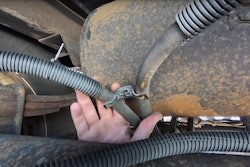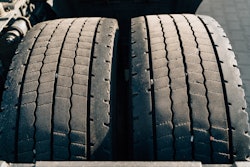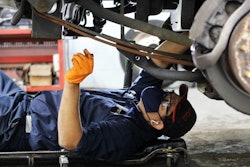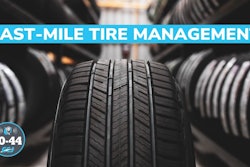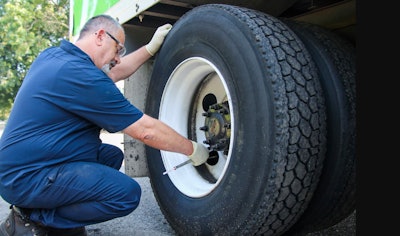
Seen any green caps on truck and trailer tires recently? Probably not.
Those hard-to-miss caps are a telltale sign that those tires are filled with nitrogen, which tire experts say reduces air pressure loss and eliminates moisture that accompanies ambient air.
“One of the benefits of nitrogen is that it does not diffuse through the inner-liner of the tire as quickly as air,” said Greg Kidd, application engineer for Bridgestone Americas tire operations. “Therefore, nitrogen does reduce inflation pressure loss over time when compared with air.”
Race car teams that are particularly cautious about maintaining proper tire pressure have used nitrogen for years. Airlines too. But what about truck fleets?
More than a decade ago, stories rolled out announcing fleets that had signed up for nitrogen by acquiring machines that can render the common element from the air, which Kidd pointed out contains “a combination of about 78% nitrogen, 21% oxygen, 1% argon and other trace gases.”
But as the years ticked away, technology supporting tire pressure monitoring systems (TPMS) improved and helped fleets to more consistently maintain ideal tire pressure while out on the road; something that’s more of a challenge for nitrogen users.
[Related: Autonomous tech tackles tire issues]
Once a truck leaves the terminal with its tires filled with nitrogen, those tires will have to be inflated with nitrogen while on the road to realize the benefits. Even small amounts of oxygen will compromise the outcome. That’s one of the reasons why Ryder System skipped out on using the gas.
“A nitrogen tire inflation program can be effective to aid tire performance if a 95% nitrogen saturation level inside the tire air chamber is maintained. Below this level, the program does not add benefits to a tire program,” said Ryder Director for National Tire Maintenance Elijah Williams. “Additionally, there is limited availability of nitrogen inflation stations and few providers who can support the program if a vehicle is outside of the Ryder network.”
 Ryder System's director for national tire maintenance Elijah Williams said they don't use nitrogen for tire inflation because "there is limited availability of nitrogen inflation stations and few providers who can support the program if a vehicle is outside of the Ryder network."Ryder System
Ryder System's director for national tire maintenance Elijah Williams said they don't use nitrogen for tire inflation because "there is limited availability of nitrogen inflation stations and few providers who can support the program if a vehicle is outside of the Ryder network."Ryder System
“That's been in our study forever and none of these fleets use it,” said NACFE executive director Mike Roeth, "but we keep hearing about it out in the field.”
Roeth added that nitrogen use may be more confined to smaller carriers and owner-operators, but in the meantime they plan on keeping nitrogen on their list of fuel-saving tips.
“We actually talked about taking it off but we decided to keep it on just in case, and so we keep asking the fleets year over year,” Roeth said.
The upfront cost to switch to nitrogen can also keep some fleets away. Prices for commercial tire generators CCJ spotted online ranged mostly from $8,000 to $15,000.
“The two primary disadvantages of nitrogen use are added cost and issues related to availability,” Kidd said.
That’s where TPMS has stepped up to help fleets to more consistently achieve ideal tire pressures.
“Certainly, TPMS systems have improved the monitoring and visibility of tire inflation pressure overall,” Kidd said. “A good inflation pressure maintenance program, coupled with a TPMS system, should yield positive results in maintaining consistent inflation pressure.”
Don’t count nitrogen out
Nitrogen can still play a vital role for fleets, particularly for those that have equipment that sits for long periods of time, according to Frank Ruscitti, owner of NitrogenMan, a marketer of nitrogen generators for commercial fleets near Pittsburg, Pennsylvania.
“We did a company outside of Pittsburgh two years ago that does lowboy hauling and those trailers sit and sit and sit,” Ruscitti said. “Every time they went out West, they lost tires. It’s because those trailers sit and those tires deteriorate.”
[Related: Bridgestone rolls out tire program for smaller last-mile fleets]
Ruscitti said when nitrogen takes the place of oxygen it eliminates moisture that accompanies ambient air.
“As trailers sit, any moisture that’s in that compressed air sits in the bottom of that tire and it eventually permeates into the rubber,” Ruscitti said, "and then – when you have oxygen with heat – you get oxidation. So normally when tires blow, they blow at that weak point where that moisture was.”
Kidd said that since nitrogen cuts out moisture, it can also benefit sensitive TPMS electronics.
“It is important to note that nitrogen inflation utilizes dry inflation, where air inflation typically contains water and water vapor,” Kidd explained. “The presence of water in air-inflated tires can have a negative effect on TPMS sensors, potentially causing them to report inaccurate readings or fail prematurely. Thus, it is important for fleets to maintain dry air when using air inflation.”
If nitrogen is not an option, Kidd said moisture can be purged “by utilizing a dependable dryer near the compressor output, as well as a drain or some type of moisture-removing device at each airline drop within the shop.”
However, as it stands now, shops are more likely to use air dryers given the higher upfront cost of switching to nitrogen.
“I am not aware of a trucking fleet in North America that is utilizing nitrogen inflation,” Kidd said. “It’s mostly typically used in aircraft and racing tires, and occasionally in off-road tires.”
Editor's note: CCJ reached out to fleets that had announced nitrogen programs in the past and did not hear back from any of those sources by press time.



